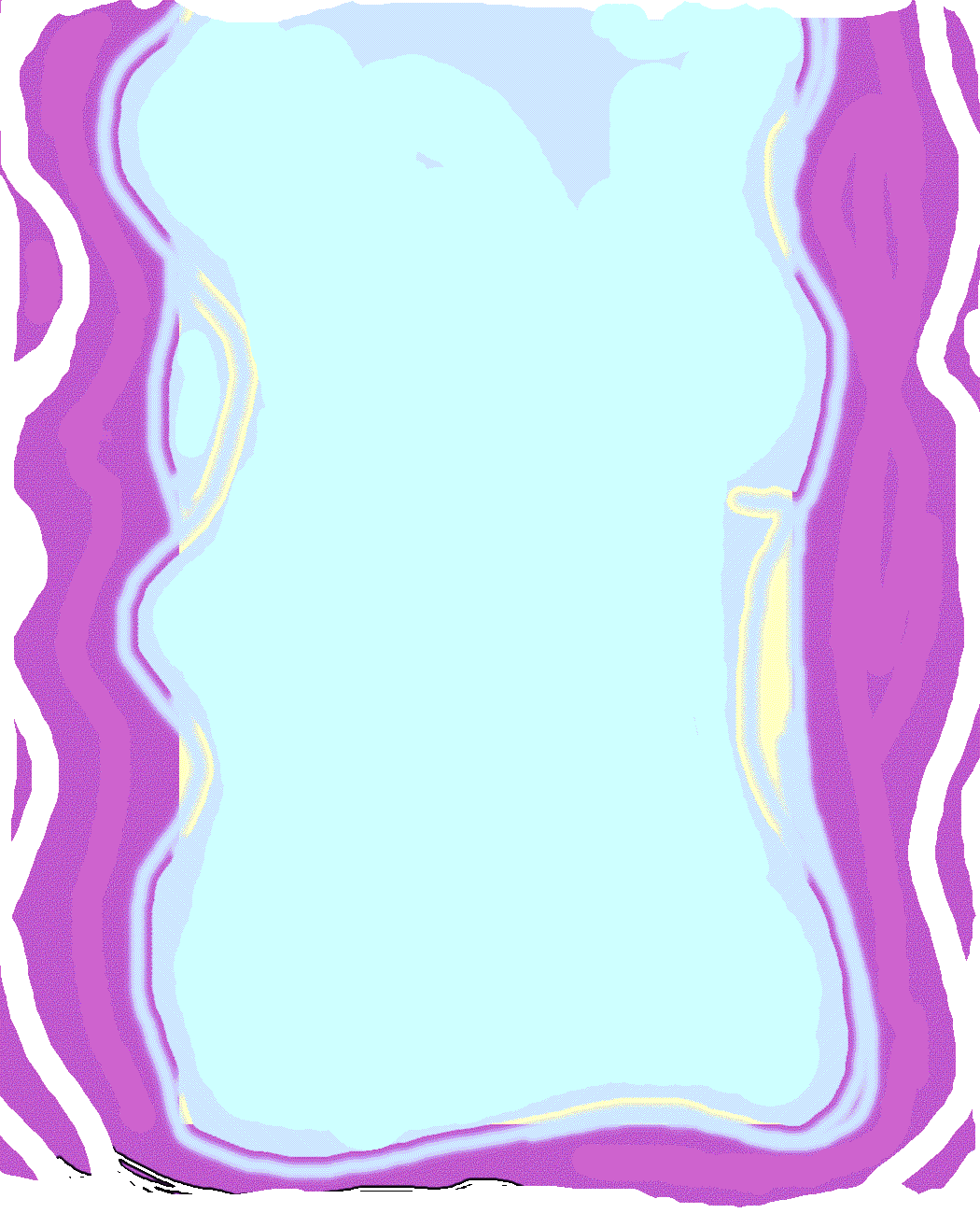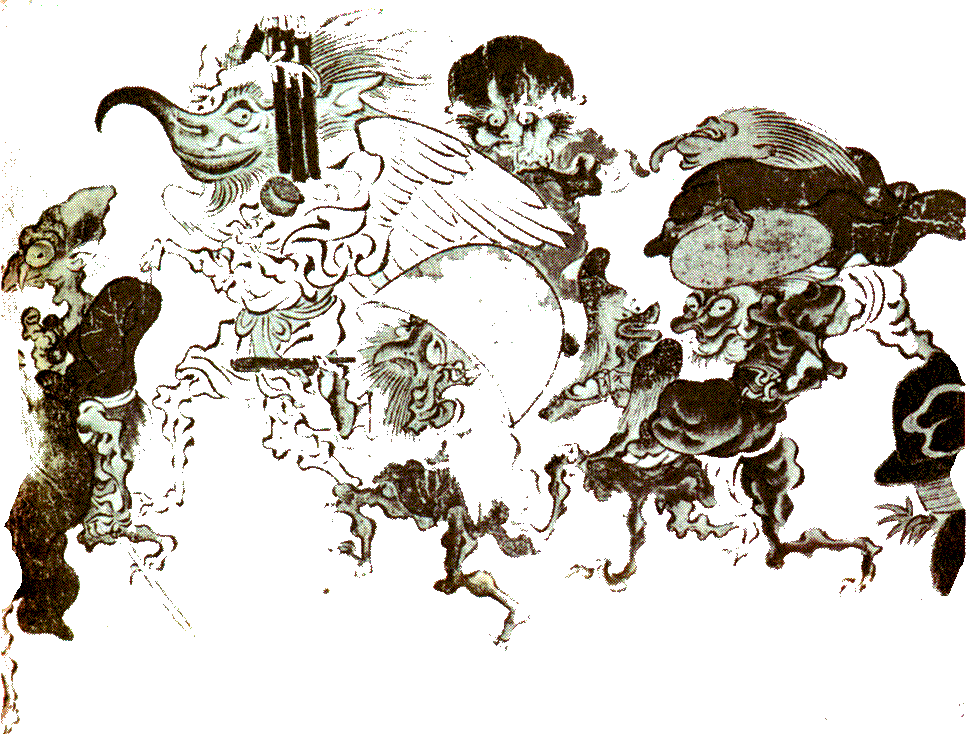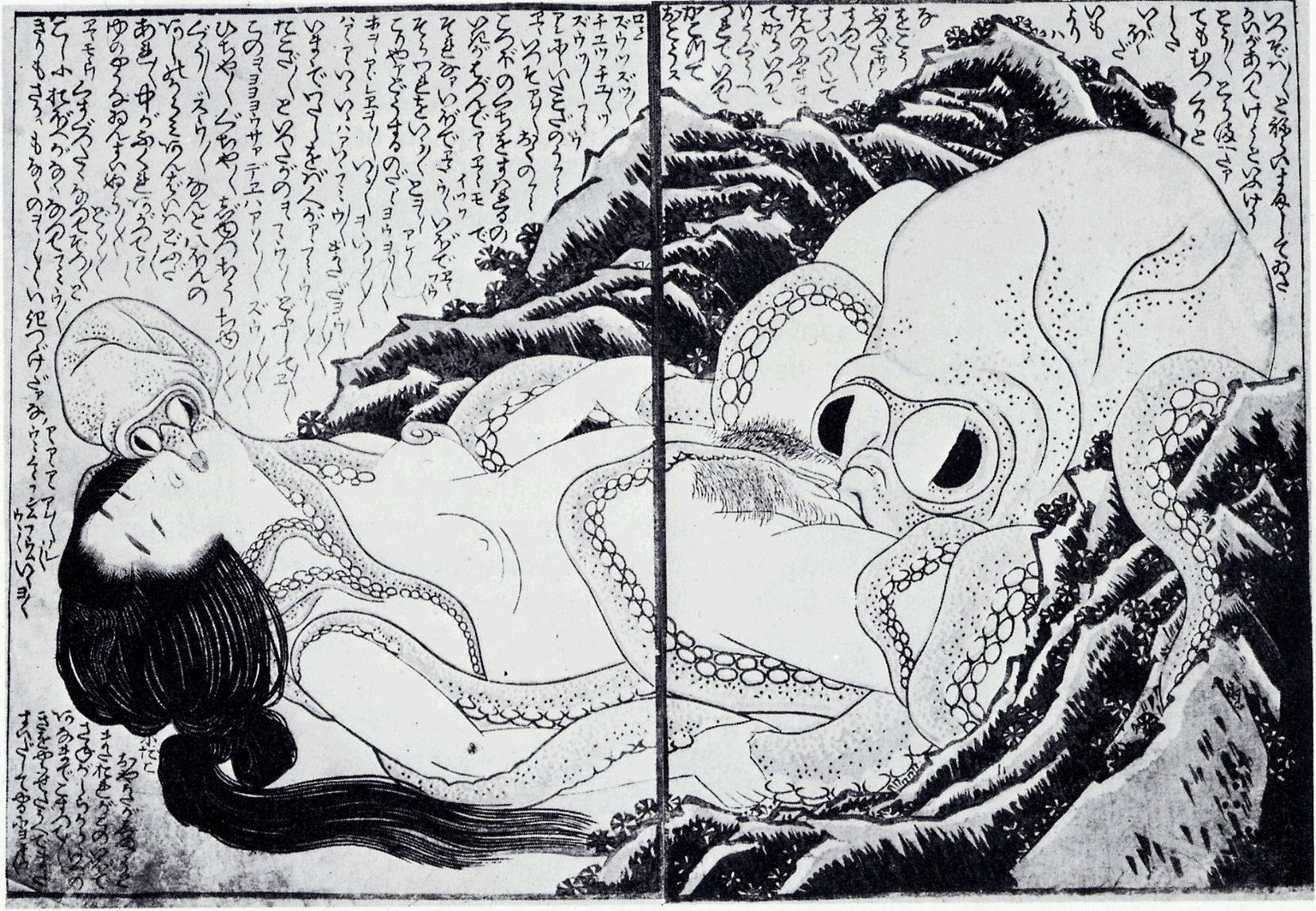


Susan
Napier (Susan Napier,
“The Fantastic in Modern Japanese Literature. The Subversion of Modernity,”
London and New York, 1996, 9).described fantasy in manga
as:
"any conscious departure from consensus reality.."
Contemporary manga spans all types of topics and genres. Manga may come in the form of a comic strip in an inexpensive magazine. In fact, manga is closely tied with the generally accepted idea of a comic book. The word manga comes from two characters; man which means spontaneous, funny, involuntary or ‘in spite of oneself,’ and ga, which means pictures.
Like the comics of today [manga], ukiyo-e [prints and books]
were part of the popular culture of their time: They were lively, topical,
cheap, entertaining, and playful. Masters of the genre regularly infused their
works with humor, experimented with deformation of line, and dabbled in the
fantastic, the macabre, and the erotic. (Frederik
Schodt, “Manga! Manga! The World of Japanese Comics”,Tokyo, New
York, London, Kodansha International, 1983, 34-35)
Ukiyo-e prints and Kabuki theatre, both from the Edo period, were considered to be low forms of entertainment in the same way that the modern form of expression, called manga, is considered to be a low form of Japanese entertainment today.
One of these early humorists was Ukiyo-e artist Katsushika Hokusai
(1760 – 1849), who was best known in the West for his Thirty-six
views of Mount Fuji
series (There are actually 46 oban sized prints in this series). Especially
The Breaking Wave of Kanagawa
(Richard Lane, Images
from the Floating World: The Japanese Print,(Hong Kong, Konecky and Konecky,
1978), 167).
Hokusai is considered the founder of the word manga. From 1814 through 1878 he published fifteen volumes of ‘whimsical sketches’ that he called manga, which were originally intended as a source of copybooks for his students. To Hokusai, manga probably meant caricature and exaggeration. Hokusai’s Blind Men and Elephant (from his Hokusai manga series “whimsical Sketches” volume VIII, 13 and 14) shows the comic nature of blind men trying to figure out what an elephant looks like by merely touching it. Another example of Hokusai’s manga is the comical facial contortions present in these figures (Paul Gravett, Manga. Sixty years of Japanese Comics, Laurence King Publishing, 2004, 18) and Figures on the Street, (Figure, Lane, 273. Page from the Hokusai manga series I, hanshi-bon, 1814).
Bishop Toba, another early comic book artist, was a twelfth Century Buddhist
priest who created Chojugiga or the “Frolicking
Animal Scrolls.” Chojugiga were humorous pictures of birds
and animals. This narrative picture scroll was not divided into frames as
is present day manga, but rather as a continuum in time. It set the stage
for telling a story by its design of creating a sense of the passage of time,
which occurs in contemporary anime. Bishop Toba’s satiric work involved
the nobility and the clergy, and it is humorous and fantastic. (Schodt,
Dreamland Japan, 22, and
figures 18 and 19, Schodt Dreamland, 29-30).
Another great caricaturist of the time was Utagawa Kuniyoshi, who drew humorous characters such as his “Random Drawings on a Storehouse Wall” (Tadashi Kobayashi, Ukiyo-e. An Introduction to Japanese Woodblock Prints, Japan, Kodansha International, 1997, 94; and Lane, 299).
Other scrolls of the time were uninhibited and humorous, such as the “Farting Scrolls,”or Hohigassen (Schodt, Manga! Manga!, 29-31). These scrolls are considered to be the world’s first comic books. Toba pictures, called toba-e (Schodt, Manga! Manga!,37), were mass produced in the 18th century with ‘yellow jacket books’ called kibyoshi via woodblock printing as entertainment picture books during the Edo period. The first e-iribon or illustrated book was called “A Tale of Manly Love.” (Kobayashi, 69).
Other genres include kinpira-bon (tales of heroism), (Kobayashi, 69) and koshoku-bon (erotic literature). Ukiyo-zoshi or ‘floating-world novels’ were illustrated narrative books using pictures with a flat perspective. An example is shown here from Characters of Worldly Young Men, (Paul Gravett, Manga. Sixty years of Japanese Comics, (Laurence King Publishing, 2004), 20) which was written by Kiseki Ejima (1715).
Hishikawa Moronobu, who lived during the Edo period, made over 150 illustrated e-iribon books. Sharaku Toshusai, an ukiyo-e artist who lived during the 18th century Edo period, was a master of caricature ( figures shown here) (Lane 124-125).
Yoshitoshi Tsukioka (1839-92) had stylized blood splatters that are similar to the ones seen in action manga today. (Schodt, Manga! Manga!, 35) It can be seen that from the earliest comic books from the 12th through the 18th century, the spirit of entertainment of the Edo period has lived on to the present day, influencing modern comic books (manga).
In modern times, the world manga, synonymous with Japanese comics,
is considered ‘low brow’ by the Japanese culture. The physical
structure or design of manga which are sequential panels with words
was influenced by early 20th century American comic strips (such as Bringing
up Father by George McManus); (Schodt
Dreamland, 35). Many publications use the word komikkusu in
its place, which is considered to be a more sophisticated and refined term.
Simple cartoons have been called toba-e, giga (playful pictures), or ponchi-e (after British ‘Punch and Judy’ fame). (Schodt, Dreamland, 35). These cartoons, as Ukiyo-e art was in the past, are cheaply mass produced. However, the popularity stems from the ideas rooted in manga. Manga encompasses many genres: original works (Orijinaru), parodies of animation (aniparo), love between gay males (ju-ne mono) beautiful young girls (bishojo), Lolita complex (rorikon) and ya-o-I, (From the phrase YAma-nashi, Ochi-nashi, and Imi-nashi, meaning “no climax, no punch line, no meaning….” (Schodt, Dreamland, 37). Shojo manga (Antonia Levi, Understanding Japanese Animation, Carus publishing Company, 1996, 10-11) is for women and girls. Shonen manga is for boys and men, (Ibid 9). Gekiga manga (‘dramatic pictures’) is a more realistic and contemporary life style type of manga.
Creative freedom of expression and consumption, present in the Floating World,
are ideas firmly rooted in the culture of manga, resulting in its’
contemporary popularity. This creative freedom is related to the fact that
Japanese culture is based on a relatively amoral universe when compared to
the Judeo-Christian philosophy of good triumphing over evil present in Western
culture. In contrast to the United States, Japanese society is more tolerant
of sex in its writings and its visual works. There is supposedly more freedom,
to mock the social order and political correctness, which is not the case
in the United States.
Manga can be many things: violence, bad taste, excessive human feelings,
peaceful, fantastic, utopian, or apocalyptic. Manga can be a witty
book, reminiscent of the Edo period Sharebon. (James
Araki, “Sharebon: Books for Men of Mode”, Monumenta Nipponica,
21, (1969), 31-45). It can also be made into works that are
business manuals or historical in nature. Basically, manga encompasses
all facets of society and is deeply rooted in cultural and social change.
Sharon Kinsella identifies the roots of manga in the Japanese pre-war culture during the 1950’s:
"Story manga, developed by early pioneers of the contemporary form, expanded rapidly during the 1960’s, when it became linked to political radicalism and counter-cultural experimentation".
"From the mid-eighties large corporations, cultural institutions, and government agencies in Japan reached out towards the manga medium and attempted to draw it closer to the state. This happened through two superficially antithecal trends – a censorship movement and an active process of cultural assimilation".
"Manga was a child of the sixties. Like rock and roll, it records the imagination, (but not the voice), of radical drop-out life. Across its pages have flowed most of the most extreme, individualistic and uncontrolled expressions to pass through the Japanese media in the post-war years. To the extent that the best of its millions of volumes have been preserved (only just), manga remains a record of the special qualities of euphoria, desire, disappointment, yearning, weakness, aspiration, depression, loneliness, madness, banality, and satire that characterizes the mood of Japan in the post-war era. It has been a very sociable medium. Its pages teem with characters, whose aspirations, frustrations, and adventures form the substance of manga series. Manga characters tend to embody aspects of caricature, they have exaggerated facial expressions, they swoon, they sweat, they cry, they bleed, they are visibly excited, shocked, distraught, embarrassed, and amused. It is possible that highly expressive and emotionally readable manga characters have held a particular attraction in a contemporary environment which has encouraged high levels of self-discipline and a more controlled mode of physical and facial expression. Manga culture has been an important extra dimension for communicating new attitudes and dealing with subjective issues. The focus on how people felt has given manga an unwitting humanistic value." (Sharon Kinsella, “Adult Manga: Pro-Establishment Pop-Culture and New Politics in the 1990’s”, Media Culture and Society, vol. 21, 1999. http://ebasic.easily.co.uk/04F022/036051/manga.html)
This statement is important since contemporary society may reflect a similar repressive character that also existed in the Edo period, and contributed to the characteristics of Ukiyo period works.
In Susan Napier’s book, The Fantastic in Modern Japanese Literature, she discusses the alien in modern Japanese fantasy, as a means to explore the self. She questions if in a postmodern world is there even a fixed self to find since change is so ubiquitous. (Napier, Fantastic, 93) Literary alternative beings, or aliens, are also personified in manga. Two types of alien are of interest for the discussion in this paper: the ghost, and the monster, both of which were present in the Japan of premodern times.
The vengeful ghost, usually female, is the mainstay of most premodern horror
stories and of the popular kabuki theater and also appears frequently in woodblock
prints (figures here). (Napier,
Fantastic 95; Lane 168 and 266; Schodt, 31)
Another example would be Hokusai’s erotic and fantastic Girl Diver and Octopi (Lane,163) a fantasy where a large octopus performs cunnilingus on an enraptured female diver (shown below).
Perhaps it is the artificiality of these characters that allows humans to distance themselves from these works in such a manner that what the fantasy character paradoxically does is lead humans into accepting the uncanny as the ‘real.’ These personae are also present in contemporary manga and anime, clearly demonstrating that they are in the realm of the fantastic. Unlike the presumed purpose of ‘realism’, the fantastic is an attempt to not scientifically observe and represent the world as we know it:
"The
fantastic implies that we cannot know the world." (Napier,
Fantastic, 7).
The post apocalyptic is another important genre in manga and anime. The existence of the apocalyptic genre is easy to understand simply in light of the horrific destruction of life and society that occurred from the nuclear bombing of Hiroshima and Nagasaki during World War II.
A summary of overlapping characteristics of manga and anime and the Edo Period philosophy is listed here:

